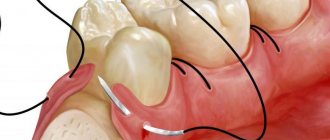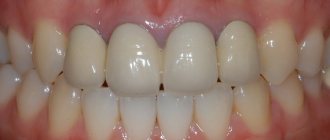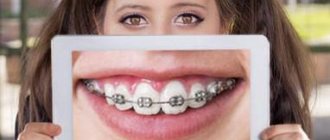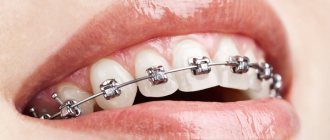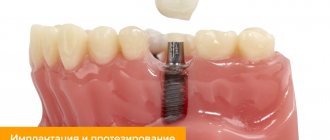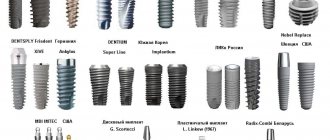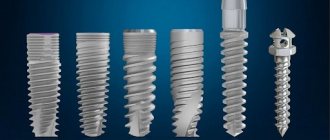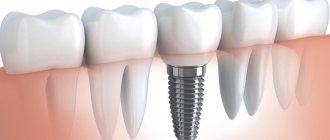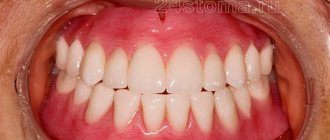Immersion of a dental implant into bone tissue is a surgical operation. During this procedure, the dentist cuts the soft tissue and removes the mucoperiosteal flap to gain access to the bone. After all installation procedures are completed, the gum is sutured to protect the implant installation area from infection. As a rule, sutures are removed after implantation no earlier than 7 days. Most often on the 10–14th day. These deadlines may vary in each individual case.
Types of materials for sutures in implantology
Dental practice uses several types of suture materials. All of them are classified into self-absorbable and non-absorbable.
Absorbable include
- Catgut;
- dexon;
- vicryl.
Catgut has been used for more than a century and is a classic. The threads dissolve in about two weeks due to the action of phagocytosis and enzymes. The disadvantage of the material is the ability to provoke tissue inflammation due to foreign proteins contained in its composition. The use of catgut during implantation is not recommended.
Dexon and vicryl are synthetic materials. The active substance of the first is polyglycomic acid, the second is polylactin. Resorption is promoted by hydrolysis. The period of complete dissolution takes about a month. Suppuration practically does not occur when using these threads.
Non-absorbable threads
- Silk;
- woven polyester;
- monofilament.
Silk , consisting of silkworm proteins, is often used by surgeons, but not for fixing bone grafts. It has one drawback - sometimes an inflammatory process develops in the area of the sutures. Braided polyester threads serve their purpose well, without complications.
Monofilament sutures with good mechanical properties are most suitable for implantology They do not cause reactions and are suitable for prolonged contact with the oral mucosa. The only negative aspect of the material is the rough ends. The problem is solved by fixing them with a special bandage.
How does healing occur, what consequences of the operation are considered normal?
It is worth mentioning right away that the process of implant integration does not end with the regeneration of soft tissues - osteogenesis must occur, that is, fusion of the bone with the implant. It takes about six months for complete restoration of both bone and soft tissue, starting from the day the pin was installed - even with a step-by-step procedure, this is usually enough. But at the VivaDent clinic, patients are warned that the speed of healing varies from person to person - there are lucky ones who, after three months, do not notice any consequences of the intervention, but there are those patients who really need six months or a little more for full recovery .
In the first hours after surgery, the patient feels numbness - these are residual effects of pain relief. Then a slight pain appears - since the cut tissue cannot help but hurt after the anesthetic wears off, and this is normal. Patients describe the nature of the pain as “pulsating” or “twitching”, and these sensations spread to the jaw area around the socket of the implanted tooth. But you don’t have to endure them at all - the dentist will recommend what painkillers you can use to cope with the pain. As a rule, the pain goes away within four to five days after the intervention.
During the first week, itching in the gums is also possible - and this is considered a normal phenomenon during tissue regeneration.
A month after implantation, the patient stops experiencing any painful or uncomfortable sensations completely - as the surface of the gum and the place where it connects to the abutment heals.
Bleeding from the gums should stop within the first 24 hours (and even then, we are not talking about continuous streams of blood, but drops); then, over the course of several days, the appearance of a small amount of blood or exudate cannot be ruled out.
Also, in the first five days, a slight increase in temperature and the presence of slight swelling of the gums in the area of intervention are considered acceptable. Sometimes the gums of neighboring teeth also swell - this is also normal if it does not last longer than a few days.
If sutures were placed on the gums, the patient should come for examination weekly or more often (as the doctor says), and the sutures will be removed 3-4 weeks after the gums have been sutured.
Care instructions
Regular treatment of the operated mucosal area promotes successful healing. The procedure consists of several stages.
- Daily three-time antimicrobial rinses with Tantum Verde solution.
- To protect the tongue from damage by the hard ends of the threads, it is necessary to smear the operated area with Solcoseryl adhesive paste. It promotes rapid regeneration of the damaged area.
- Drug therapy includes taking Calcium d3 Nycomed, multivitamin complexes, painkillers (if the gums hurt). Anti-inflammatory drugs are prescribed to reduce swelling.
Additionally, the following rules must be observed:
- give up solid food, hot dishes, drinks, hot spices, coffee (increases blood pressure);
- do not use a hard toothbrush;
- avoid intense training and heavy lifting;
- do not visit the sauna, bathhouse;
- stop smoking: cigarette smoke negatively affects the mucous membranes and increases the risk of inflammation.
- The diet should include pureed soups, boiled porridges, and broths.
It is important to maintain oral hygiene to avoid the proliferation of pathogenic microorganisms. You need to brush your teeth carefully, without touching the operated area.
Introduction
We hope you did everything correctly before implantation, carried out all the necessary tests and diagnostics, prepared comprehensively, and now, after its successful implementation, all that remains is to follow the following recommendations after dental implantation.
But, if you are just preparing for dental implantation, then all the materials in this section will be extremely useful to you. And if you want to place implants with the highest quality and reliability, we recommend contacting our Research Center clinics, which have been successfully operating in Moscow for more than 10 years. And they are the best not only in Moscow, but also in Russia according to dental ratings. Sometimes it is better not to skimp on your health, since you will live with implants for the rest of your life, and the quality and further maintenance of implant systems should come to the fore. Remember the simple folk truth “The miser pays twice”: poorly installed implants can lead to their rejection and inflammation of the bone tissue. Yes, installing implants with us is not cheap, but we solved this problem for you!
Financial support for dental implantation
Do you want to undergo high-quality dental implantation in our clinics, but have a financial problem? This can be solved! From July 20, 2020
You can also use the dental implantation service in installments.
note
that some of the material is accompanied by a video from our YouTube channel, we recommend spending a little of your precious time and watching the videos, it will be useful.
More than 1,000 patients
use the recommendations of medical specialists from the Research Center on YouTube every day .
Why is it important to follow the recommendations after implantation?
Firstly
, dental implantation is a serious surgical intervention involving bone tissue deformation. And it takes time for the bone structure to heal. The recommendations of the attending physician allow the bone tissue to heal and osseointegrate into the dental implant as quickly as possible. Do you know what can result from the fact that the implant does not take root due to your failure to follow the recommendations? Let's read the next point #2, which is also the most important. And this is not a joke, but the sad experience of violating patients.
Secondly
, non-compliance with recommendations sharply increases the risk of developing inflammation at the implant site - peri-implantitis, followed by implant rejection or removal. Moreover, inflammation can occur both in the first months after installation of the implant, and after a year or two or three. Below we provide clinical examples of peri-implantitis that developed in patients, leading to the removal of the implant. Therefore, be careful and follow the recommendations.
In general, high-quality dental implantation is absolutely painless for the patient. The importance and role of implantation in human health cannot be overestimated. The biggest problem with implantation is that there is swelling after the operation. It can last for about 3 days
, but even then not always.
After dental implantation, the patient must understand that he will have a certain medication load: he must take antibiotics, antimicrobial drugs, and take baths with an antiseptic. And, of course, follow the doctor’s recommendations.
What to do if the suture breaks after implantation
There are times when the threads have weakened and come apart. This does not threaten the implant falling out, but there is a risk of infection . The situation must be corrected urgently.
After the examination, the doctor will take the necessary antiseptic measures and prescribe rinses. The recovery period after long complex operations is sometimes accompanied by antibiotic therapy. The rehabilitation course for each patient is compiled individually. If the tissues have not yet fused, the specialist will have to remove the stitches and then apply new ones.
Possible complications
The risk of complications after implantation remains, especially if you choose an inexperienced doctor and violate general recommendations. Patients who have autoimmune diseases, weak immunity, and chronic diseases require special attention.
The most common complications of implantation are:
- implant rejection, development of peri-implantitis;
- damage to blood vessels and nerves of the face;
- bone atrophy;
- the appearance of bone growths;
- bleeding;
- seam divergence;
- pronounced swelling of the gums.
Natural reactions of the body to tissue damage during implantation such as swelling and moderate pain are not considered complications. To prevent swelling from increasing on the first day after surgery, it is necessary to apply dry ice to the cheek for 10 minutes, taking a break every 20-30 minutes. If your health worsens, it is worth visiting a dentist.
Some patients experience an increase in body temperature after implantation. For mild hyperthermia, there is no need to worry. If severe fever occurs, especially against the background of swelling and hyperemia of the gums, you should seek help from professionals. In this way, dangerous infectious complications can occur.
Suture removal after implantation
Patients are always interested in the question “On what day after implantation are the sutures removed?” Usually, for those whose healing went well and there was no suppuration, the threads are removed after 10-14 days. All this time, the area above the implant must be treated with antiseptics and protected from injury. The first days after surgery, you may feel as if threads are being pulled. Often there is a discharge of ichor. After the thread extraction procedure, which is absolutely painless, the doctor will recommend continuing the preventive course.
What affects the timing of suture removal?
Gum healing sometimes occurs with peculiarities. The rate of tissue regeneration is influenced by the following factors:
- patient's age;
- the presence of chronic diseases;
- bad habits that persist after implantation;
- volume of surgical intervention.
Healing time may be delayed if a person has diabetes or smokes. In this case, the stitches are most often removed after two weeks.
The date for removal of the suture material is determined by the dentist. It is important to come on the specified day, since performing this procedure late may lead to undesirable consequences.
What to do next
The implantation process is quite long. After the threads are removed, the mucous membrane continues to grow over the implant. It shouldn't be visible. This takes approximately two months. Then prosthetics are performed. Installed orthopedic structures require careful care. The patient needs to master the technique of daily procedures that will help maintain a beautiful, healthy smile for a long time. These include:
- using a brush with soft bristles;
- brushing teeth twice a day;
- flossing;
- cleaning the areas where the implants come into contact with the gums using an irrigator;
- If plaque has formed, visit the dental office to remove it.
Patients who have undergone implantation should periodically visit specialists. This will help extend the service life of structures and avoid complications.
Is it possible to carry out simultaneous implantation?
Patients are attracted by the opportunity to undergo implantation immediately after tooth extraction or loss. But this is not possible in all cases. Immediate implantation is carried out if there is sufficient volume and level of bone density. Otherwise, the implant will not be able to take root well.
If the bone is less than 2-4mm, it is more likely to be resorbed, causing the gums to recede. Weak bone tissue should not be subjected to chewing loads. The implant may become loose. Then it will need to be removed.
Immediate implantation is used in cases of unexpected tooth loss, for example, during an accident or sports training. In this case, the jaw bone has full volume and can be used to install an artificial root.
You will learn more about possible complications and rules for recovery after implantation from the specialists of our dental clinic.
Installation of the crown part
The penultimate stage of implantation is prosthetics (building up the crown part of an artificial tooth). It is carried out 1–2 weeks after fixation of the abutment. May take different times depending on the type of crown chosen. Options:
- removable denture (budget option, justifies itself when replacing 4 or more teeth);
- fixed dentures (bridge or single);
- conditionally removable;
- combined options.
Regardless of the choice of prosthesis, its preparation is carried out in several stages. In the first step, the orthodontist makes an impression of the jaw. The procedure takes no more than 10 minutes and is performed without pain or discomfort. Necessary for making a crown of the correct shape and size in accordance with the structure of the jaw.
The second stage is the production of prostheses. The patient is not involved here. Crown elements are performed in the laboratory of the selected clinic within 2–4 weeks, depending on the choice of material (metal-ceramics, ceramics, precious metals).
At the third stage, a series of fittings and adjustments of the prosthesis to the patient’s bite is carried out. As soon as this process is completed, they are installed (using special locks if this is a removable model, or adhesive material if the dentures are permanent).
Causes of seam divergence
The seams after screwing in the implant may come apart for various reasons. The main ones are:
- the patient violates the doctor’s recommendations regarding care of the postoperative area;
- poor oral hygiene;
- the doctor made a mistake when performing treatment and used low-quality materials;
- individual intolerance to the materials used;
- serious damage to the jaw bone.
When are sutures placed after tooth extraction?
It is usually necessary to suturing a wound after tooth extraction in the following cases:
- The most common sutures are applied after the removal of a wisdom tooth - “eights” are usually considered the most difficult in terms of surgical interventions and often require a special approach.
- To prevent bleeding - if the dentist does not have the time and opportunity to find out reliably whether the patient has a tendency to bleed (the operation must be performed urgently, because there is no time to do blood tests).
- During the extirpation of impacted and dystopic teeth, as well as severely destroyed ones (when the crown, in fact, no longer remains above the gum surface) or with significantly curved roots. In all these cases, an incision is made into the gums and underlying tissues, and therefore, after completion of the operation, suturing of the wound edges will be required.
The dental surgeon tightens the edges of the wound (puts the gum flap in place in the area of the incision) and sutures them with catgut or polyamide thread. In the first case, the suture material dissolves on its own; in the second, the threads will need to be removed by the dentist.
If you have a problem similar to that described in this article, be sure to contact our specialists. Don't diagnose yourself!
Why you should call us now:
- We will answer all your questions in 3 minutes
- Free consultation
- The average work experience of doctors is 12 years
- Convenient location of clinics
Single contact phone number: +7
Make an appointment
Installation of the healing abutment
A gum abutment is a temporary structure that is placed to create a natural contour around artificial teeth. It is a titanium cylinder that is screwed into a pin and worn for at least 2 weeks. Installation of the former is performed under local anesthesia, takes up to half an hour (incision - fixation - suturing) and also requires rehabilitation (from 4 days).
